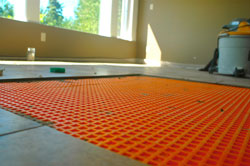 Ceramic tiles are one of the longest lasting, easiest to care for and most beautiful flooring options available, though none of this matters to the distressed homeowners who write to me looking in vain for solutions to the problem of constantly cracking tiles and loosening grout. Stories like this show up in emails to me all the time, but all I can offer is what these people probably fear; failing ceramic floors are frustrating, troublesome and irreparable. You either get the installation right the first time, or the whole thing becomes a mess of regret. If you’re planning to install ceramic tiles at your place, be sure to include one crucial feature that delivers great reliability. I know for a fact that any one of hundreds of homeowners would love to do it all again, putting this feature into practice.
Ceramic tiles are one of the longest lasting, easiest to care for and most beautiful flooring options available, though none of this matters to the distressed homeowners who write to me looking in vain for solutions to the problem of constantly cracking tiles and loosening grout. Stories like this show up in emails to me all the time, but all I can offer is what these people probably fear; failing ceramic floors are frustrating, troublesome and irreparable. You either get the installation right the first time, or the whole thing becomes a mess of regret. If you’re planning to install ceramic tiles at your place, be sure to include one crucial feature that delivers great reliability. I know for a fact that any one of hundreds of homeowners would love to do it all again, putting this feature into practice.
Although rigid support of ceramic tiles by the subfloor is essential, it’s not enough. Even adding a layer of cement board over your existing subfloor before tiling may not be sufficient to stop trouble. Even if it was, why slug heavy cement board into your home when a lighter weight alternative does a better job. The issue boils down to a hidden but damaging dynamic that often happens when differences in the expansion and contraction rates of tiles and subfloors work against each other as temperature and humidity levels change. Even if your subfloor gets a mere 1/8-inch longer or shorter than an entire room full of tiles that stay the same size, the resulting side pressures can be huge and damaging. And while the mechanics of tension/compression stresses may seem obscure, they are common enough to be part of quite a few failed ceramic tile installations. This is especially true in Canada, with wide swings in relative humidity over the course of the year. This is also precisely where something called uncoupling membranes can help. They allow slight side-to-side movement of the tiles in relation to the subfloor, relieving stress while still providing complete tile support from underneath.
 Uncoupling membranes boost tile reliability when installed over both wood subfloors and concrete, but they require three key installation details. Typical installations over wood-based subfloors begins by moistening the surface of the wood with water. This prevents moisture from being drawn out of the thinset mortar you’ll put down next for bedding the uncoupling membrane. Sponge on just enough water to thoroughly wet the wood, though not so much that there’s standing water. Wait five or 10 minutes before troweling on thinset using a square tooth trowel or a vee-notched trowel. You know you’ve got enough mortar applied when it completely covers the underside of the uncoupling membrane as you pull up a corner for inspection.
Uncoupling membranes boost tile reliability when installed over both wood subfloors and concrete, but they require three key installation details. Typical installations over wood-based subfloors begins by moistening the surface of the wood with water. This prevents moisture from being drawn out of the thinset mortar you’ll put down next for bedding the uncoupling membrane. Sponge on just enough water to thoroughly wet the wood, though not so much that there’s standing water. Wait five or 10 minutes before troweling on thinset using a square tooth trowel or a vee-notched trowel. You know you’ve got enough mortar applied when it completely covers the underside of the uncoupling membrane as you pull up a corner for inspection.
The choice of thinset mortar type is key, and sometimes even professionals get confused. Something called “modified thinset” is ideal for installations over porous surfaces like wood and unpainted concrete. When thinset mortar is applied between two impervious layers, such as the tiles themselves and a plastic uncoupling membrane, or new tiles installed over previous tiles, modified thinset is a mistake. The chemical composition means it won’t harden properly in this situation, and that’s why “unmodified thinset” is necessary here. At least one uncoupling membrane manufacturer I know offers a full five year warranty on the entire tile installation if it fails after following prescribed installation methods. Removal of old tile, purchasing new tile and reinstallation costs are covered.
Properly installed ceramic tiles will last for decades, and it’s a sad waste when it doesn’t. The fact that not all tile installations endure proves that improved practices are required. Modern methods and materials make it easier and faster to install tiles once and for all, but this only happens for those people open enough to try something different. Overcoming the inertia of tradition may be the biggest hurdle of all when it comes to creating our own reliable tile.


